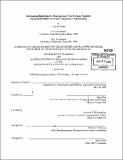Developing high-density housing near Tren Urbano stations : financial feasibility for transit supportive condominiums
Author(s)
Riley, Colin M., 1964-
DownloadFull printable version (18.22Mb)
Other Contributors
Massachusetts Institute of Technology. Dept. of Urban Studies and Planning.
Advisor
Qing Shen and Kenneth E. Kruckemeyer.
Terms of use
Metadata
Show full item recordAbstract
The confluence of rail transit and real estate development opportunities in San Juan, Puerto Rico raises a number of questions related to the future built form of the city and surrounding region. As the construction of Tren Urbano nears completion many advocate transit supportive development that captures the social benefits that results for public investment in Tren Urbano. Private developers have been slow to react to the potential for transit supportive real housing. This research brings together the urban design ideas expressed in New Urbanism and real estate investment decision modeling to forecast the potential for building transit supportive housing at the Martinez Nadal station within the next two years. The analysis shows that market demand for high-density housing in San Juan is strong, a reflection of rising income levels in Puerto Rico and an increase in the number of households. In addition, recent housing development in the Greater San Juan region has started to shift to mid-rise walk-ups and highrise condominiums. However, the link between high-density housing and rail transit is still not firmly established In terms of the financial decision modeling for future transit supportive housing, the Capital Asset Pricing Model (CAPM) is used to estimate a risk-adjusted discount rate for housing development. The Net Present Value (NPV) and Internal Rate of Return (IRR) investment decision rules are applied to four stylized housing programs synthesized from recent housing development practice in San Juan. The investment potential of the stylized housing projects is evaluated under different conditions. First, the result from a market development that ignores the impact of the transit system is established. The model then adjusts for reduced parking ratios to account for transit supportive housing. In one case, the results show that the investment will continue to be profitable up to a six percent reduction in the average price for a condominium unit when the parking is reduced from two spaces per dwelling to a more transit friendly ratio of one space. In another case, the size of the public subsidy that is required to develop the housing is estimated to be 15 percent of total development cost. The results show that there is a real opportunity for transit supportive housing in San Juan. However, Tren Urbano will need to play an active role in getting projects such as these off the ground. Key words: Transit supportive housing, reduced parking, sound investment practice, densification, condominium ownership, developer's required return on equity.
Description
Thesis (M.C.P.)--Massachusetts Institute of Technology, Dept. of Urban Studies and Planning, 2000. Includes bibliographical references (leaves 134-135).
Date issued
2000Department
Massachusetts Institute of Technology. Department of Urban Studies and PlanningPublisher
Massachusetts Institute of Technology
Keywords
Urban Studies and Planning.